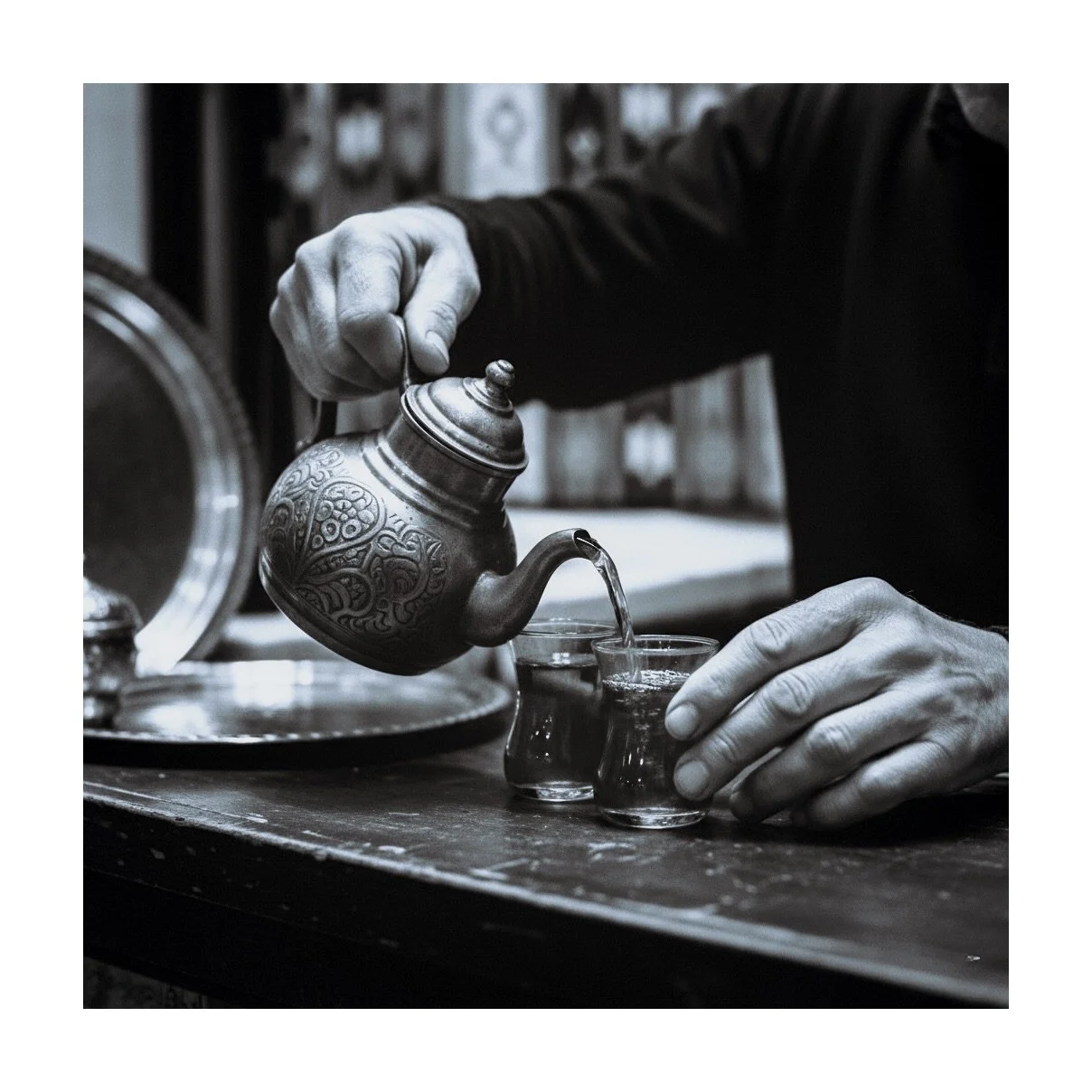Layers & Turkish Coffee
Light, Layers & Turkish Coffee: A Photographer’s Stroll Through Istanbul
1. Arrival: The Airport of Eternal Questions
Some cities greet you with silence, and then there’s Istanbul — a place that immediately hands you a cup of tea, a smile, and mild existential confusion about where Europe ends and Asia begins.
I arrived armed with my Hasselblad 500 (because art must have weight) and the Contax G2, that sleek little time machine with autofocus faster than my thoughts. Together, they formed an unlikely duo — one a cathedral, the other a dagger.
At passport control, the officer stared at my camera bag.
“Professional?” he asked.
“Emotionally, yes,” I replied.
He smiled and stamped me in.
Outside, the air smelled of roasted chestnuts, diesel, sea salt, and a history that had seen too much and yet refused to retire.
2. Morning on Istiklal: Where Time Wears Perfume
The first light in Beyoğlu felt like something sacred — soft, dusty gold pouring over the cobblestones. I loaded the Hasselblad, the film winding like a ritual chant. Each clack of the shutter echoed against façades that had witnessed centuries of markets, music, and revolution.
Istanbul doesn’t reveal itself politely; it seduces by contradiction. One moment, a man sells simit from a cart that looks older than democracy; the next, a teenager passes wearing sneakers that could fund a small country.
The Contax G2 loved this city. Autofocus locked on faces in the tram window, hands exchanging tea, eyes half-lost in thought. Every frame felt cinematic — as if Orhan Pamuk had whispered into the lens.
A street cat rubbed against my leg. I took its portrait. It looked unimpressed, as most cats in Istanbul do.
Street Photography Tip #1:
In Istanbul, don’t chase subjects — they appear when you pause long enough to smell the coffee.
3. The Grand Bazaar: Geometry, Gold, and a Photographer’s Doom
Entering the Grand Bazaar is like stepping inside a kaleidoscope built by storytellers.
Light filters through domes and arches, bouncing off brass, silk, and the occasional existential crisis of a photographer drowning in detail.
Everywhere — movement, color, noise.
The Hasselblad felt absurd here — too solemn, too heavy. Yet I raised it, framed a stall of lamps shimmering like captured constellations, and waited for the perfect human silhouette to pass.
Click.
A moment of silence in chaos.
Then a shopkeeper approached.
“Film?” he asked, tilting his head.
“Yes.”
He nodded, deeply approving. “Old way. Better soul.”
We shared tea. I photographed his hands, cracked and steady, as he poured amber into small glass cups.
Street Photography Tip #2:
Respect the merchants — they’ve mastered lighting centuries before softboxes existed.
4. Galata Bridge: The Theater of the Everyday
By noon, I reached the Galata Bridge, that eternal stage of Istanbul where fishermen, ferries, and philosophers share the same view.
The Contax hung from my shoulder, eager and quick. The Hasselblad stayed tucked in my bag, pouting. The sun painted everything in a theatrical glow — the water a sheet of mercury, the skyline a crown of domes and minarets.
I photographed men fishing while smoking, tourists pretending not to be tourists, and an old couple eating simit in synchronized bites. Every frame smelled faintly of salt and time.
One fisherman glanced at my camera.
“Old camera?”
“Yes.”
He smiled. “So you take old photos too?”
“Hopefully timeless,” I said.
He laughed. “Everything old is timeless here.”
Street Photography Tip #3:
Shoot layers — Istanbul is built on them. Reflections, crowds, colors, stories. Stack them like baklava.
5. The Call to Prayer and the Call of Light
As afternoon drifted toward gold, the adhan rose through the air — not from one mosque, but from many, each voice overlapping in haunting harmony. The city paused, briefly. Even the cats seemed contemplative.
I climbed toward Süleymaniye Mosque, each step a test of both faith and leg muscles. The view at the top was worth every complaint: domes rolling toward the Bosphorus, gulls suspended in amber light, smoke curling from tea stalls below.
I set the Hasselblad on the ledge, composed a frame with the skyline blurred by haze, and waited for a lone figure to step into the scene.
He did — carrying bread, silhouetted against the fading gold.
Click.
No digital playback. Just trust and hope — the old alchemy of film.
Street Photography Tip #4:
Patience is exposure. The city rewards those who wait longer than its noise.
6. Evening in Kadıköy: The Other Side of the River
Crossing to Kadıköy by ferry felt like traveling through time and temperament.
On the European side, you frame history; on the Asian side, you frame life.
The ferry moved through soft mist, gulls tracing perfect diagonals across the sky. I leaned on the railing, Contax ready. The film advanced like a heartbeat.
At the terminal, street musicians played melancholy covers of love songs no one had forgotten. A man sold roasted corn beside a neon-lit kebab stand. Couples argued in whispers. The light turned electric.
I shot until my film ran out — and when it did, I kept seeing frames everywhere, as if the city had printed itself onto my retina.
I ordered Turkish coffee so strong it could develop film. The waiter laughed when I asked for sugar. “You don’t sweeten truth,” he said.
7. Night: Between Two Continents
At night, Istanbul becomes a reflection of itself — mosques glowing like lanterns, ferries crossing the black water like thoughts between hemispheres.
I set up the Hasselblad on a wall near Karaköy, loaded my last roll. The shutter sounded like a closing prayer.
In that moment, I realized something quietly absurd yet comforting:
Every photo I’d taken was already history.
And every step I’d walked was already memory.
The Hasselblad, the Contax, even the film — they weren’t just tools; they were translators. Between time and vision. Between the city and me.
A cat brushed against my leg again. Maybe the same one from the morning. Maybe Istanbul itself is saying goodbye.
8. Reflections Before Departure
The next morning, I walked to the water one last time. Fishermen were already there, as if they’d never left. The air was thick with sea and smoke and Sunday slowness.
I didn’t take a single photo. Some moments belong unframed.
I thought of what I’d learned — that Istanbul isn’t a city, it’s a conversation. Between continents, centuries, and cameras. Between chaos and calm. Between knowing and simply observing.
Traveling here wasn’t about capturing the perfect image; it was about surrendering to the imperfect rhythm of a place that refuses to be still.
And as I packed my gear — film rolls labeled “Hope,” “Luck,” and “Too Dark Maybe” — I felt that familiar ache photographers know: the wish to stay just one more day, one more frame, one more light.
Epilogue: On Seeing Slowly
When people ask how Istanbul was, I tell them it’s the only city where light tastes like history and sound moves like prayer.
The Hasselblad taught me reverence; the Contax taught me agility. Istanbul taught me that both can coexist — in one footstep, one frame, one fleeting breath of the Bosphorus.
Because, in the end, street photography isn’t about catching life — it’s about being caught by it.














